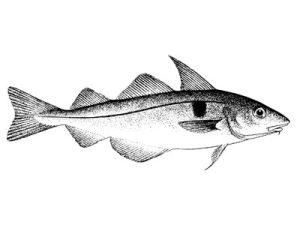
The Atlantic haddock is a member of the cod family, but it is smaller than the Atlantic cod, generally weighing 2-5 pounds.
Haddock are easily recognized by a black lateral line running along the side and a distinctive dark blotch above the pectoral fin, often described as a “thumbprint”, the “Devil’s thumbprint” or “St. Peter’s mark”.
Haddock are found from the Western North Atlantic from Labrador to Cape Charles, Virginia, the Eastern North Atlantic from Bay of Biscay to Spitzbergen; Barents Sea; around Iceland and southern tip of Greenland. Two major North American stocks thrive on Georges Bank and in the southwestern Gulf of Maine.
Haddock is a mild white fish known for its excellent table quality. Haddock is a great source of low-fat protein and is high in magnesium and selenium. Haddock fillets are white, mild and very similar to Atlantic cod.
Haddock is sold fresh, smoked, frozen, dried, or to a small extent canned. Haddock, along with cod and plaice, is one of the most popular fish used in British fish and chips. Small fresh haddock and cod fillets are often sold as scrod in New England The term refers to the size of the fish which have a variety of sizes, i.e. scrod, markets, and cows.
Haddock may be prepared in the same manner as other members of the cod family, keeping in mind that it has a more delicate texture than cod. It is lean and white like cod and produces large flakes once cooked.
Popular cooking methods include poaching, baking, steaming and broiling. Haddock is also very popular smoked in Europe and Scandinavia where it is marketed as finnan haddie.
Related Information